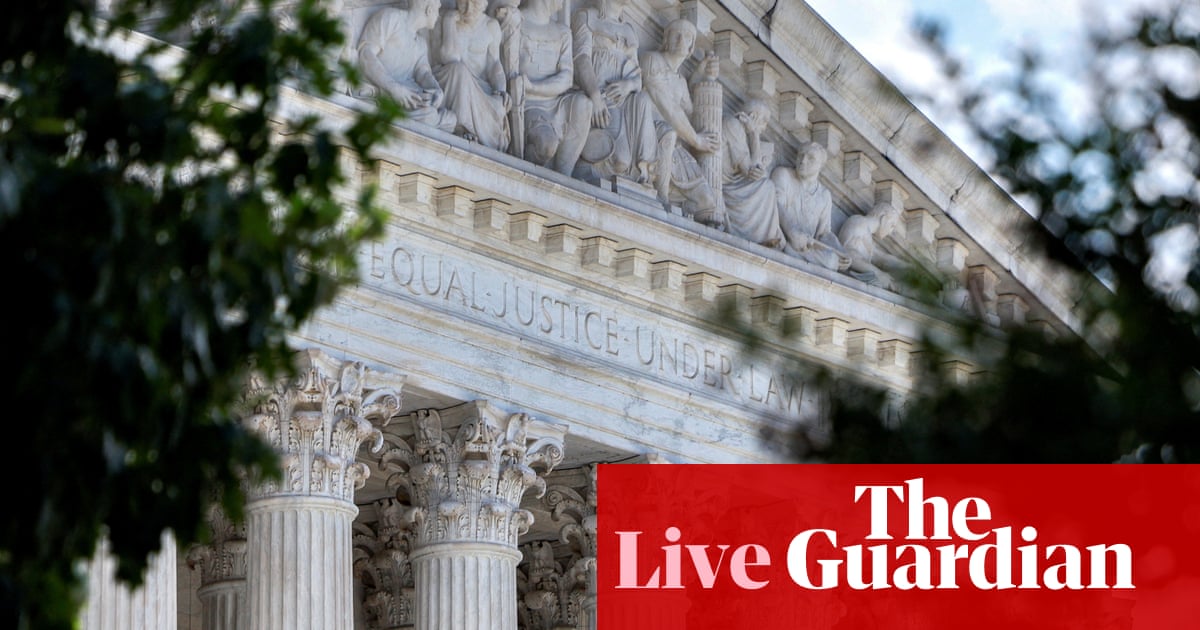Supreme court lets Trump administration strip ‘parole’ status from half a million migrants from four countries
The supreme court has allowed Donald Trump’s administration to revoke the temporary legal status of hundreds of thousands of Venezuelan, Cuban, Haitian and Nicaraguan migrants living in the United States, Reuters reports, bolstering the president’s drive to step up deportations.
The court put on hold Boston-based US district judge Indira Talwani order halting the administration’s move to end the immigration “parole” granted to 532,000 of these migrants under Joe Biden, potentially exposing many of them to rapid removal, while the case plays out in lower courts.
As with many of the court’s orders issued in an emergency fashion, the decision was unsigned and gave no reasoning. Two of the court’s three liberal justices, Ketanji Brown Jackson and Sonia Sotomayor, publicly dissented.
The court botched its assessment of whether the administration was entitled to freeze Talwani’s decision pending the litigation, Jackson wrote in an accompanying opinion. The outcome, Jackson wrote, “undervalues the devastating consequences of allowing the government to precipitously upend the lives and livelihoods of nearly half a million noncitizens while their legal claims are pending”.
Immigration parole is a form of temporary permission under US law to be in the country for “urgent humanitarian reasons or significant public benefit”, allowing recipients to live and work in the United States. Biden used parole as part of his administration’s approach by to deter illegal immigration at the US-Mexican border.
Trump called for ending humanitarian parole programs in an executive order signed on 20 January, his first day back in office. The Department of Homeland Security subsequently moved to terminate them in March, cutting short the two-year parole grants. The administration said revoking the parole status would make it easier to place migrants in a fast-track deportation process called “expedited removal”.
The plaintiffs, a group of migrants granted parole and Americans who serve as their sponsors, sued administration officials claiming the administration violated federal law governing the actions of government agencies.
Talwani in April found that the law governing such parole did not allow for the program’s blanket termination, instead requiring a case-by-case review. The Boston-based 1st US circuit court of appeals declined to put the judge’s decision on hold.
In its filing, the justice department told the supreme court that Talwani’s order had upended “critical immigration policies that are carefully calibrated to deter illegal entry”, effectively “undoing democratically approved policies that featured heavily in the November election” that returned Trump to the presidency.
The plaintiffs told the supreme court they would face grave harm if their parole is cut short given that the administration has indefinitely suspended processing their pending applications for asylum and other immigration relief. They said they would be separated from their families and immediately subject to expedited deportation “to the same despotic and unstable countries from which they fled, where many will face serious risks of danger, persecution and even death”.
Key events
Golden Dome missile defense program won’t be done by end of Trump’s term

Hugo Lowell
Donald Trump’s so-called Golden Dome missile defense program – which will feature space-based weapons to intercept strikes against the US – is not expected to be ready before the end of his term, despite his prediction that it would be completed within the next three years.
In the Oval Office last week, when he announced that the US space force would oversee the project under Gen Michael Guetlein, the president said he was confident that it would be “fully operational” before he left office.
But the implementation plan for the Golden Dome produced by the Pentagon, as described by two people familiar with the matter, envisions having the defense weapons being ready only for a demonstration and under perfect conditions by the end of 2028.
The Golden Dome program is effectively becoming operational in phases as opposed to it coming online all at once. Initially, the Pentagon is set to focus on integrating data systems before developing space-based weapons later, the people said.
What might be possible in 18 months is for the US to have the foundations of a fully operational Golden Dome, where a military network of satellites and space-based communication systems could track hundreds of inbound missiles towards the US.
There would be no capability to take out the missiles using space-based weapons at that stage. The US has roughly 40 Patriot defense batteries in Alaska and California that could be used to kill potential intercontinental ballistic missiles.
By the end of Trump’s term, instead, the Pentagon could have the network of space-based sensors and communications, and attempt to integrate it with untested space-based weapons to shoot them down.
The space-based network is likely to rely heavily on Elon Musk’s SpaceX, which has been developing a next-generation tracking system known as the “aerial moving target identifier”. The defense department acquired the first prototypes last year during the Biden administration.
But the flagship concept for Golden Dome, to identify and kill ballistic missiles in the first 30 seconds to two minutes of launch when their heat signature is greatest – known as “boost phase” – is not expected to be ready.
That technology remains in development and it may not be feasible for years for a counter-missile launched from space to cut through Earth’s atmosphere with enough force to eliminate a ballistic missile, the people said.
Elon Musk allegedly took large amounts of drugs including ketamine while advising Trump – NYT
Joseph Gedeon
Elon Musk engaged in extensive drug consumption while serving as one of Donald Trump’s closest advisers, taking ketamine so frequently it caused bladder problems and traveling with a daily supply of approximately 20 pills, an investigation from the New York Times (paywall) has revealed.
The world’s richest man regularly consumed ketamine, ecstasy and psychedelic mushrooms during his rise to political prominence, anonymous sources familiar with his activities told the Times. His drug use reportedly intensified as he donated $275m to Trump’s presidential campaign and later wielded significant power through his role spearheading the “department of government efficiency”, or Doge.
Musk announced his departure from government service on Wednesday evening, months after exhibiting erratic behavior including insulting cabinet members and making a Nazi-like salute at a political rally.
The Doge leader developed what sources described to the Times as a serious ketamine habit, consuming the powerful anesthetic sometimes daily rather than the “small amount” taken “about once every two weeks” he claimed in interviews. “If you’ve used too much ketamine, you can’t really get work done, and I have a lot of work,” Musk previously told journalist Don Lemon in March 2024, downplaying his consumption.
However, by spring last year, the Times reports that Musk was telling associates his ketamine use was affecting his bladder – a known consequence of chronic abuse of the drug, which has psychedelic properties and can cause dissociation from reality, according to the DEA.
His regular medication box contained pills bearing Adderall markings alongside other substances, according to sources with the Times who have seen photographs of the container.
It remains unclear whether Musk was under the influence during his time at the White House, where he attended sensitive meetings with foreign leaders and held power over federal spending cuts.
The White House did not return a request for comment on whether Musk underwent drug testing despite his access to classified information.
White House says US considering other actions on China amid trade spat
The Trump administration is preparing to take other actions targeting China, the White House deputy chief of staff for policy has said following Donald Trump’s accusation that Beijing had “totally violated” its preliminary trade agreement with the US.
“That opens up all manner of action for the United States to ensure future compliance,” Stephen Miller told reporters.
“There are measures that have already been taken, there are measures that are being taken, there are measures that are being considered,” he said separately on CNN. “It would be incredibly unwise for China to continue down this path and not seek instead the path of cooperation.”
It’s been a few hours since Trump’s post on Truth Social but he’s yet to explain the action taken by China that has allegedly violated the agreement, but a US official told Reuters that it appears China was moving slowly on promises to issue export licenses for rare earths minerals.
The Geneva agreement called for China to lift trade countermeasures that restrict its exports of the critical metals needed for US semiconductor, electronics and defense production.
Trump’s trade representative Jamieson Greer also said this morning that critical minerals was one area of particular concern. He told CNBC earlier:
We haven’t seen the flow of some of those critical minerals as they were supposed to be doing … China continues to, you know, slow down and choke off things like critical minerals and rare earth magnets.
It follows comments from treasury secretary Scott Bessent yesterday stating that trade talks between the US and China were “a bit stalled” and getting a deal over the finish line will likely need the direct involvement of Trump and Chinese president Xi Jinping.
Max Planck Society, one of Europe’s leading research bodies, has seen a threefold surge in applications from US researchers following the Trump administration’s attacks on higher education in the US, Reuters reported.
The German state-backed network of research centers received over triple the amount of applications from the US this spring compared to last year in its latest call for early-career scientists looking to set up their own research labs.
“What’s interesting is the number of applications from other parts of the world remained constant,” Patrick Cramer, president of the Max Planck Society, told Reuters. “If you look at which institutions these applications are coming from, you see almost half are concentrated at five institutions: Harvard, Stanford, MIT, the National Institutes of Health and the University of California.”
The flood of applicants comes at a time of concern over a potential American “brain drain” where scientists and researchers in the US are considering leaving the country to pursue foreign research opportunities.
Biden urges defense of democracy, in first speech since cancer reveal

Joanna Walters
Joe Biden just gave a speech in Delaware, his first since he was diagnosed earlier this month with an aggressive form of prostate cancer that has spread to his bones.
The former president was commemorating fallen members of the military, in a week that began with the Memorial Day holiday that is traditionally dedicated to remembering those killed in service. He drew a direct line between their sacrifice and what Americans need to do now.
“They are not asking us to risk our lives, they are asking us to stay true to what America stands for. They are not asking us to do their jobs, they are asking us do our jobs – to protect our nation, in our time, now, to defend democracy.”
Biden, a Democrat, did not mention his successor, Donald Trump, and the Republican president’s self-referential Memorial Day address or his thrust to expand his presidential power in what critics say is a threat to the rule of law and US democracy, but he did not need to.
Biden also did not refer to his cancer or any treatment. He sounded vigorous and impassioned. He delivered the speech in New Castle as his family also marked the 10-year anniversary of the death of his son Beau, from brain cancer at the age of 46.
The Centers for Disease Control and Prevention (CDC) has removed language that says healthy children should get COVID vaccines. The public health agency has posted new recommendations that healthy children may, but no longer should, get COVID-19 shots, the Associated Press reported.
The change comes days after US health secretary Robert F. Kennedy Jr. announced that COVID-19 vaccines will no longer be recommended for healthy children and pregnant women, though the CDC website did not appear to substantially change recommendations for pregnant women.
The US has cut awards to 24 green energy projects, including to an Exxon refinery complex in Texas issued during former President Joe Biden’s administration that totaled more than $3.7 billion, the Energy Department confirmed on Friday to Reuters.
The Trump administration has said it is “reevaluating” publicly-funded awards and loans issued to emerging technology projects during Biden’s administration. The administration has so far dismantled several of Biden’s policies on climate and clean energy while pursuing a very pro-oil agenda.
The Office of Clean Energy Demonstration awards the department axed include nearly $332 million to a project at Exxon Mobil’s Baytown, Texas refinery complex, $500 million to Heidelberg Materials, US in Louisiana, and $375 million to Eastman Chemical Company in Longview, Texas.
In another case, the supreme court on 19 May also allowed the Trump administration to end a deportation protection called temporary protected status that had been granted by Joe Biden to about 350,000 Venezuelans living in the United States, while that legal dispute plays out.
In a bid to reduce illegal border crossings, Biden starting in 2022 allowed Venezuelans who entered the United States by air to request a two-year parole if they passed security checks and had a US financial sponsor. Biden expanded that process to Cubans, Haitians and Nicaraguans in 2023 as his administration grappled with high levels of illegal immigration from those nations.
Supreme court lets Trump administration strip ‘parole’ status from half a million migrants from four countries
The supreme court has allowed Donald Trump’s administration to revoke the temporary legal status of hundreds of thousands of Venezuelan, Cuban, Haitian and Nicaraguan migrants living in the United States, Reuters reports, bolstering the president’s drive to step up deportations.
The court put on hold Boston-based US district judge Indira Talwani order halting the administration’s move to end the immigration “parole” granted to 532,000 of these migrants under Joe Biden, potentially exposing many of them to rapid removal, while the case plays out in lower courts.
As with many of the court’s orders issued in an emergency fashion, the decision was unsigned and gave no reasoning. Two of the court’s three liberal justices, Ketanji Brown Jackson and Sonia Sotomayor, publicly dissented.
The court botched its assessment of whether the administration was entitled to freeze Talwani’s decision pending the litigation, Jackson wrote in an accompanying opinion. The outcome, Jackson wrote, “undervalues the devastating consequences of allowing the government to precipitously upend the lives and livelihoods of nearly half a million noncitizens while their legal claims are pending”.
Immigration parole is a form of temporary permission under US law to be in the country for “urgent humanitarian reasons or significant public benefit”, allowing recipients to live and work in the United States. Biden used parole as part of his administration’s approach by to deter illegal immigration at the US-Mexican border.
Trump called for ending humanitarian parole programs in an executive order signed on 20 January, his first day back in office. The Department of Homeland Security subsequently moved to terminate them in March, cutting short the two-year parole grants. The administration said revoking the parole status would make it easier to place migrants in a fast-track deportation process called “expedited removal”.
The plaintiffs, a group of migrants granted parole and Americans who serve as their sponsors, sued administration officials claiming the administration violated federal law governing the actions of government agencies.
Talwani in April found that the law governing such parole did not allow for the program’s blanket termination, instead requiring a case-by-case review. The Boston-based 1st US circuit court of appeals declined to put the judge’s decision on hold.
In its filing, the justice department told the supreme court that Talwani’s order had upended “critical immigration policies that are carefully calibrated to deter illegal entry”, effectively “undoing democratically approved policies that featured heavily in the November election” that returned Trump to the presidency.
The plaintiffs told the supreme court they would face grave harm if their parole is cut short given that the administration has indefinitely suspended processing their pending applications for asylum and other immigration relief. They said they would be separated from their families and immediately subject to expedited deportation “to the same despotic and unstable countries from which they fled, where many will face serious risks of danger, persecution and even death”.
China moving slow to approve exports of rare earth minerals – Reuters
While Trump did not provide an explanation to his allegation that China had “totally violated” the terms of the agreement reached with the US in Geneva, Reuters has been told by a US official that it appears China was moving slow on promises to issue export licenses for rare earth minerals.
Earlier US trade representative Jamieson Greer’s told CNBC:
The Chinese are slow-rolling their compliance, which is completely unacceptable and it has to be addressed.
According to the Wall Street Journal, Greer said the flow of critical minerals from China, which had been cut off by Chinese trade countermeasures, has not resumed as called for by the Geneva agreement.
A spokesperson for China’s embassy in Washington did not immediately respond to a Reuters request for comment. Spokespersons for the White House, the US Treasury and the US Trade Representative’s Office also did not respond to requests for comment.
Trump administration orders extra vetting of ‘online presence’ of all visa applicants linked to Harvard University
The state department has ordered all its consular missions overseas to begin additional vetting of visa applicants looking to travel to Harvard for any purpose, according to an internal cable seen by Reuters on Friday, in a significant expansion of Donald Trump’s crackdown against the embattled elite university.
In a cable dated 30 May and sent to all US diplomatic and consular posts, secretary of state Marco Rubio instructed the immediate start of “additional vetting of any non-immigrant visa applicant seeking to travel to Harvard University for any purpose”.
Such applicants include but are not limited to prospective students, students, faculty, employees, contractors, guest speakers, and tourists, the cable said. Harvard University “failed to maintain a campus environment free from violence and anti-Semitism”, the cable said, citing the Department of Homeland Security and therefore the enhanced vetting measures aim to help consular officers identify visa applicants “with histories of anti-Semitic harassment and violence”.
The order also directs consular officers to consider questioning the credibility of the applicant if the individual’s social media accounts are private and instruct them to ask the applicant to set their accounts to public.
The additional measures on Harvard were first reported by Fox News, but the cable itself has not been previously reported.
The state department did not immediately respond to a Reuters request for comment.
The move is part of the Trump administration’s intensifying immigration crackdown and follows Rubio’s order to stop scheduling new appointments for student and exchange visitor visa applicants. The secretary of state also said earlier this week that Washington will start revoking the visas of Chinese students with links to the Chinese Communist Party and those who are working on critical areas.
The Trump administration has launched a multifront attack on the nation’s oldest and wealthiest university, freezing billions of dollars in grants and other funding, proposing to end its tax-exempt status and opening an investigation into whether it discriminated against white, Asian, male or straight employees or job applicants.
Trump alleges top US universities are cradles of “anti-American” movements. In a dramatic escalation, his administration last week revoked Harvard’s ability to enrol foreign students, a move later blocked by a federal judge.
Here’s the full Truth post from Trump earlier this morning, in which he claims he moved to make a trade deal with China not out of any US self-interest whatsoever – but “to save them” from a “devastating” situation, factory closings and civil unrest caused by his tariffs of up to 145% on Chinese imports.
Two weeks ago China was in grave economic danger! The very high Tariffs I set made it virtually impossible for China to TRADE into the United States marketplace which is, by far, number one in the World. We went, in effect, COLD TURKEY with China, and it was devastating for them. Many factories closed and there was, to put it mildly, “civil unrest.” I saw what was happening and didn’t like it, for them, not for us. I made a FAST DEAL with China in order to save them from what I thought was going to be a very bad situation, and I didn’t want to see that happen. Because of this deal, everything quickly stabilized and China got back to business as usual. Everybody was happy! That is the good news!!! The bad news is that China, perhaps not surprisingly to some, HAS TOTALLY VIOLATED ITS AGREEMENT WITH US. So much for being Mr. NICE GUY!
Greer says Trump administration ‘very concerned’ with and must address Chinese ‘non-compliance’
Echoing Trump’s accusation this morning that China has “totally violated” the terms of its preliminary trade agreement with the US, US trade representative Jamieson Greer told CNBC “we’re very concerned with” China’s purported non-compliance with the temporary trade deal.
Per his CNBC interview, Greer said the “United States did exactly what it was supposed to do, and the Chinese are slow rolling their compliance”. He called that “completely unacceptable and has to be addressed”.
Trump did not explain what China had done to violate the terms of the Geneva agreement or what action Washington would take against Beijing.
It comes a day after US treasury secretary Scott Bessent told Fox News that trade talks between the US and China were “a bit stalled” and getting a deal over the finish line will likely need the direct involvement of Trump and Chinese president Xi Jinping.
From infamous salutes and multiple Maga hats (sometimes worn at the same time) to the globally detrimental mass layoffs, my colleagues have put together this timeline of Elon Musk’s highly contentious tenure at Doge.
As we reported earlier, Donald Trump and Elon Musk are due to hold a joint press conference at 1.30pm ET on what is supposed to be officially the tech billionaire’s final day working as part of the Trump administration.
Trump used his own Truth Social website to describe the X owner as “terrific” in what is clearly an attempt to quell rumours of a rift between the two men. “This will be his last day, but not really, because he will, always, be with us, helping all the way,” Trump wrote.
But after arriving the White House 130 days ago vowing to slash federal spending by $2tn (spoiler: he didn’t), “the thing that Musk has been most stunningly effective at slashing is his own reputation,” writes Guardian columnist Marina Hyde.
He arrived in Trump’s orbit as a somewhat mysterious man, widely regarded as a tech genius, and a titan of the age. He leaves it with vast numbers of people woken up to the fact he’s a weird and creepy breeding fetishist, who desperately pretends to be good at video games, and wasn’t remotely as key to Space X or Tesla’s engineering prowess as they’d vaguely thought. Also, with a number of them apparently convinced he had a botched penile implant. Rightly or wrongly convinced – sure. I’m just asking questions.
But look, it’s good news for Tesla investors, who have managed to end Musk’s practice of WFWH (working from White House), and are now demanding he puts in a 40-hour week to save the company whose stock he has spent the past few months tanking. As the world order dramatically seeks to rearrange itself in the new era of US unreliability, no one should ever be able to unsee the president of the United States’s decision to turn the White House lawn into a car sales lot for his sad friend. Did it work? It seems not. Musk spent a lot of this week airing his hurt feelings about his brrm-brrm cars. “People were burning Teslas,” he whined to Jeff Bezos’s Washington Post this week. “Why would you do that? That’s really uncool.”
Well, one thing we will no longer have to endure is this guy’s decrees on what is or isn’t cool. The timeworn thing about money and power is that they allow nerds to reinvent themselves as cool … What you rarely see is the alchemy of that process in reverse, live and in real time. But we got that with Elon, and we have to take our laughs where we can. In some other businesses, Musk could have convinced himself it wasn’t happening, but politics is a place where pollsters literally ask real people what they think of public figures every single week. Elon’s approval ratings are underwater.
Division between US and China is the biggest risk confronting world now, France’s Macron says
France’s president Emmanuel Macron has said that division between the United States and China, is the main risk currently confronting the world, as he emphasized the need for building new coalitions between Paris and partners in the Indo-Pacific.
Macron is visiting the region as France and the European Union aim to strengthen their commercial ties in Asia to offset uncertainty over Donald Trump’s tariff measures.
Speaking at the Shangri-La Dialogue, Asia’s premier defence forum, alongside a two-day state visit to Singapore, Macron said:
I will be clear, France is a friend and an ally of the United States, and is a friend, and we do cooperate – even if sometimes we disagree and compete – with China.
The French president said Asia and Europe have a common interest in preventing the disintegration of the global order.
You have to choose a side. If we do so, we will kill the global order, and we will destroy methodically, all the institutions we created after the Second World War in order to preserve peace.
The time for non-alignment has undoubtedly passed, but the time for coalitions of action has come, and requires that countries capable of acting together give themselves every means to do so.
Macron is following leaders of China, Japan and other European countries in visiting the region in recent weeks, in a sign of south east Asia’s strategic importance amid uncertainties on global supply chains and trade.
Trump says China has ‘totally violated’ agreement with US on tariffs
Donald Trump has said China had “violated” an agreement on tariffs with the United States reached in Geneva and threatened to take action in response.
“China, perhaps not surprisingly to some, HAS TOTALLY VIOLATED ITS AGREEMENT WITH US. So much for being Mr. NICE GUY!,” Trump said in a post on his Truth Social platform.
Trump didn’t explain how China had violated the agreement or what action he would take.
Trade talks between the US and China were “a bit stalled” and getting a deal over the finish line will likely need the direct involvement of Trump and Chinese president Xi Jinping, US treasury secretary Scott Bessent told Fox News yesterday.
I think that given the magnitude of the talks, given the complexity, that this is going to require [the leaders of both countries] to weigh in with each other.
Two weeks after breakthrough negotiations in Geneva that resulted in a temporary truce in the trade war between the world’s two biggest economies, Bessent said progress since then has been slow, but said he expects more talks in the next few weeks.
I believe that we will be having more talks with [China] in the next few weeks and I believe we may at some point have a call between the president and [Xi Jinping].
He added that the pair had “a very good relationship” and he was “confident that the Chinese will come to the table when President Trump makes his preferences known”.
The US-China agreement to dial back triple-digit tit-for-tat tariffs for 90 days prompted a massive relief rally in global stocks. But it did nothing to address the underlying reasons for Trump’s tariffs on Chinese goods, mainly longstanding US complaints about China’s state-dominated, export-driven economic model, leaving those issues for future talks.
US stock index futures dropped following Trump’s post this morning. Reuters reports that at 8:16am ET, Dow E-minis were down 153 points, or 0.36%, S&P 500 E-minis were down 26.5 points, or 0.45%, and Nasdaq 100 E-minis were down 102.75 points, or 0.48%.










